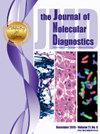A Comparative Study of Medium-Coverage Genome Sequencing and SNP Array Technology in Identifying Chromosomal Abnormalities to Advance Prenatal and Postnatal Diagnosis
IF 3.4
3区 医学
Q1 PATHOLOGY
引用次数: 0
Abstract
This study compared the performance of 5-fold genome sequencing (GS) with single nucleotide polymorphism (SNP) array technology in detecting chromosomal abnormalities, particularly in the context of prenatal and postnatal diagnostics. A total of 42 samples, previously analyzed by SNP array, were re-examined using 5-fold GS to evaluate the detection of clinically significant copy number variations (CNVs), mosaicism, and absence of heterozygosity (AOH). The results revealed a 100% concordance between the two methods for the identification of clinically relevant CNVs, with both technologies detecting similar CNV size ranges. However, 5-fold GS demonstrated better precision in defining CNV breakpoints and exhibited a lower false-positive rate, as confirmed by quantitative PCR validation. Additionally, 5-fold GS detected mosaicism with comparable sensitivity to SNP array, capturing mosaic levels as low as 17%, whereas SNP array identified levels between 15% and 84%. For AOH detection, 5-fold GS identified all candidate AOH regions with a slightly better sensitivity, achieving a detection size limit of 4.8 Mb compared with SNP array's 5.08 Mb. Overall, 5-fold GS shows potential as a reliable method for chromosomal abnormality detection, offering high accuracy and clinical utility in both prenatal and postnatal genetic testing.
中覆盖基因组测序和SNP阵列技术在染色体异常识别中的比较研究,以促进产前和产后诊断。
本研究旨在比较5倍基因组测序(GS)和单核苷酸多态性(SNP)阵列技术在检测染色体异常方面的性能,特别是在产前和产后诊断方面。先前通过SNP阵列分析的总共42个样本,使用5倍GS重新检查,以评估临床显著拷贝数变异(CNVs),镶嵌性和缺乏杂合性(AOH)的检测。结果显示,两种方法鉴定临床相关CNV的一致性为100%,两种技术检测的CNV大小范围相似。然而,qPCR验证证实,5倍GS在确定CNV断点方面表现出更好的精度,并表现出更低的假阳性率。此外,5倍GS检测马赛克的灵敏度与SNP阵列相当,捕获的马赛克水平低至17%,而SNP阵列识别的马赛克水平在15%至84%之间。对于AOH检测,5倍GS识别出所有候选AOH区域的灵敏度略高,与SNP阵列的5.08 Mb相比,检测大小限制为4.8 Mb。总体而言,5倍GS显示出作为染色体异常检测的可靠方法的潜力,在产前和产后基因检测中都具有较高的准确性和临床实用性。
本文章由计算机程序翻译,如有差异,请以英文原文为准。
求助全文
约1分钟内获得全文
求助全文
来源期刊
CiteScore
8.10
自引率
2.40%
发文量
143
审稿时长
43 days
期刊介绍:
The Journal of Molecular Diagnostics, the official publication of the Association for Molecular Pathology (AMP), co-owned by the American Society for Investigative Pathology (ASIP), seeks to publish high quality original papers on scientific advances in the translation and validation of molecular discoveries in medicine into the clinical diagnostic setting, and the description and application of technological advances in the field of molecular diagnostic medicine. The editors welcome for review articles that contain: novel discoveries or clinicopathologic correlations including studies in oncology, infectious diseases, inherited diseases, predisposition to disease, clinical informatics, or the description of polymorphisms linked to disease states or normal variations; the application of diagnostic methodologies in clinical trials; or the development of new or improved molecular methods which may be applied to diagnosis or monitoring of disease or disease predisposition.

 求助内容:
求助内容: 应助结果提醒方式:
应助结果提醒方式:


